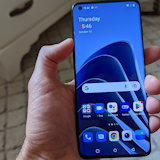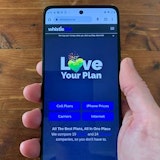 The Nokia Lumia 820 is one of the two debut smartphones for Nokia on the new Windows Phone 8 platform. Of the two, the Lumia 820 is the lower-end model and is aimed at the mid-range handset market. Despite playing second fiddle to Nokia’s current flagship, the Lumia 820 is still a surprisingly powerful and solid smartphone.
The Nokia Lumia 820 is one of the two debut smartphones for Nokia on the new Windows Phone 8 platform. Of the two, the Lumia 820 is the lower-end model and is aimed at the mid-range handset market. Despite playing second fiddle to Nokia’s current flagship, the Lumia 820 is still a surprisingly powerful and solid smartphone.
This is also the first Windows Phone 8 device we’ve had the chance to review and we have to say we were a little excited when it arrived on our doorstep. So, without any further ado, here is our Nokia Lumia 820 review.
Physical Design of the Nokia Lumia 820
As we’ve said on many occasions, Nokia is bringing color back to the smartphone game in a big way. Its vibrant device designs have been successful in the Windows Phone market, with other manufacturers like HTC already following suit with their own WP8 launch smartphones.
Before Nokia, when we thought of colored smartphones we always conjured up images of tacky, even gimmicky devices like the iNQ Cloud Touch. These devices were often aimed at teenagers and as such were cheap, sported sub-par hardware and often had little thought or care put in to their construction.
Nokia has demonstrated that a smartphone doesn’t need to be black, white or grey in order to both appear stylish or appeal to high-end users. The Lumia series boasts bold designs that catch the eye and continue to look fresh well in to the life of the phone. The Lumia 820 is a great example of this.
The Lumia 820 we received was Yellow, our favorite for this particular device, and we loved it. There’s something inherently fun about taking an everyday device and spicing it up with a simple bit of color. As a bonus, Windows Phone 8 includes a great many more options for UI themes, meaning that users can match the on-screen visuals with the casing, something that adds a little splash of validity to its uncommonly bright appearance.
What’s more, the rear plate of the Lumia 820 can be removed and replaced with one of a different color. More cases cost extra, but it’s a great way of changing up your smartphone’s look if you find yourself getting bored of the same old appearance.
 As an added bonus, or perhaps an annoying extra cost (we’re still not sure) users can purchase cases that allow for wireless charging. The standard 820 case does not allow for this, so anyone wanting that wireless charging experience will need to purchase a new one, even if they’re planning on sticking with the same color. We would have liked to see wireless charging built right in, but seeing as the 820 is not the flagship device for Nokia then we can forgive its omission. At the very least we like that this accessory replaces the rear case, meaning that only 1mm of thickness is added. This is definitely preferable to a thick external case that wraps over the existing standard option.
As an added bonus, or perhaps an annoying extra cost (we’re still not sure) users can purchase cases that allow for wireless charging. The standard 820 case does not allow for this, so anyone wanting that wireless charging experience will need to purchase a new one, even if they’re planning on sticking with the same color. We would have liked to see wireless charging built right in, but seeing as the 820 is not the flagship device for Nokia then we can forgive its omission. At the very least we like that this accessory replaces the rear case, meaning that only 1mm of thickness is added. This is definitely preferable to a thick external case that wraps over the existing standard option.
The charging cases are actually different from the standard ones. Where the standard options have a glossy finish, the charging cases are matte. We actually prefer the look of the charging cases to the standard glossy option, because they both give the 820 a bit of a more expensive appearance, as well as adding the extra grip offered by a matte texture. Interestingly the black option comes in matte for both non-charging and charging options.
It’s also worth noting that the wireless charging pads are purchased separately from the charging cases themselves. This is to encourage users to buy more than one case, should they get sick of their color scheme as we mentioned before.
The cases themselves are actually pretty tricky to remove, despite Nokia’s assurances to the contrary. A couple of times we felt as if the casing would snap and had to proceed with extreme caution. However, we didn’t end up having any accidents. Once the case is removed users have access to the removable battery, SIM card slot and MicroSD slot for expandable storage.
Overall we love the look of the colorful Lumia 820 cases, but aren’t particularly sold on the black, white and grey options. Once the color is removed the Lumia 820 appears as quite a spartan device with simple curves and straight lines. Still, anyone opting for the colored models should be pleased.
 UI and Speed
UI and Speed
The Windows Phone 8 UI is a logical step forwards from its predecessor: Windows Phone 7. While WP7 was beautiful and smooth, it lacked some elements of customisation and efficient use that iOS and Android offered. This is because WP7’s live-tile start screen only allowed one, large size for its tiles, meaning that users would often have to scroll for quite a while if they had a lot of items pinned to the start menu. There was also little variation or personalisation between devices, other than what live tiles one used and what color scheme they opted for. There was also a pointless black bar on the right hand side of the screen that pretty much did nothing but take up real estate.
Now users can resize tiles, the black bar is gone and there is a larger number of themes to choose from. It mightn’t sound like much, but this actually makes WP8 feel not only easier to use, but allows for a surprisingly deep feeling of personalisation. It also just looks more interesting at a glance, as it is more than just a uniformed layout of two equally proportioned columns. In short it feels like WP8’s start screen has graduated from a fledgling UI to a fully-operational smartphone interface.
Past the start screen, the WP8 UI boasts the same elegant beauty of its predecessor. It’s difficult to explain just how much prettier WP8 is than its competitors across the entire experience. Web searches, menus, built-in apps and even third party apps like Twitter are all appreciably more appealing than on iOS or Android.
Of course this is a purely subjective area, but going from WP8’s aesthetic design to that of another UI feels like the difference between modern website design and something from the late 90s or early 00s. Everything is just smoother, more spacious and well laid-out in terms of balancing art design with screen real estate.
One thing we absolutely love that WP8 delivers is how it interacts with a desktop or laptop. Where WP7 required the user to interface via Microsoft Zune in a very similarly restrictive way to iOS and iTunes, WP8 takes the Android route of treating the phone like an external hard drive. This is great, as it allows music, video and images to be transferred to and from a computer with extreme ease. There is an app that is designed to provide a more simplified interfacing experience, but we actually found it more confusing and difficult to use than simply accessing it as an external device.
As far as speed goes the Lumia 820 is very fast and smooth. We didn’t once get any lag or jerkiness within the UI itself. Apps opened and closed very quickly and the opening animation from the start screen is fast and fluid without seeming hurried. It adds an flourish to simple things like tapping on a tile without taking up any extra time or CPU power.
Overall the experience was everything we loved about WP7 and everything we expected from a Lumia handset with a generous amount of improvements and additions to boot. A great UI experience.
 Camera
Camera
Windows Phones have always had great camera integration. We love dedicated camera buttons and being able to jump straight to the camera from the lock screen is handy for grabbing those fleeting moments of awesome that may only ever come around once. However, traditionally Windows Phones haven’t boasted the most impressive cameras on the market in terms of image quality and low-light handling.
The Lumia 820 is one of the better WP camera’s we’ve used, but it still suffers from poor image quality once the sun begins to set. Low-light situations tend to cause pictures to come out quite hazy, with white objects casting an 80s-esque glow across the image. Think of the old cliché of two separated lovers running to each other across a sunlit meadow and that’s the kind of hazy distortion we’re talking about. It’s not as bad as many other smartphone cameras, but it’s still far from the best we’ve tested.
Video capture is also satisfactory, if not overly impressive. Once again videos during the day were generally fine. There was a bit of an issue with autofocus at times and fast-moving objects could also affect image clarity. But no more so than we’ve come to expect from smartphone cameras.
As usual, once the sun went down things deteriorated quickly. We’re still yet to find a smartphone camera that can really capture video at night time, but we’re still probably a ways off from that.
 Browsing and Keyboard
Browsing and Keyboard
The WP8 Internet Explorer (IE) browser is actually pretty fantastic. It’s well laid out, allowing for maximum screen space while still providing an easy to use interface. Moreover it’s very fast. We switched out our 4G LTE SIM card for a 3G option just to make sure we weren’t being fooled and we were still impressed. WP8 IE loads pages very quickly and renders text & images in great quality, even in 3G.
Of course, 4G connectivity is absolutely awesome if you live in a 4G supported area. Despite having a high level of familiarity with 4G already, we’re still amazed every time we use it. It really does just make using the internet almost totally hassle-free whenever the device is within range of a signal. Pages load almost instantly and apps like Facebook or Twitter that can often be laggy operate with an almost seamless ease. It’s actually quite easy to stop thinking of internet applications as 'the internet' and begin seeing them as nothing more than extensions of a phone’s user interface.
Windows Phone 8 helps to further this impression, by giving users the ability to pin specific web pages to the start screen. By creating icons for your most visited pages, the initial process of finding the page via the browser is skipped. This almost gives the web page its own specific identity within the UI, rather than relegating it to being nothing more than part of the browser. It’s a wonderful, fast and very simple way of accessing your favorite web content.
The keyboard in WP8 hasn’t noticeably changed from WP7. It’s still fast, but lacks the easy functionality of many Android keyboards. iOS users will feel at home here, as it’s very similar to Apple’s spartan approach to software keyboard design. It’s certainly functional and smooth, but it could use a little spicing up.
 Music and Media
Music and Media
Music on the Lumia 820 is a little bit different from the average WP8 device, thanks to Nokia Music. Nokia Music as an app is, in general, a fairly standard music app. It’s easy to navigate, has a smooth interface and it sports that classy Windows Phone style, complete with the panning pictures of artists and albums that we’ve come to love.
Where Nokia Music separates itself from the pack is its Gigs section. Gigs is a screen in the app that displays nearby live gigs in your area, both current and upcoming. It’s an absolutely fantastic idea and acts as a good reminder that live music actually happens all the time, at least it does if you live in a well-populated metro area.
While the Gigs section still isn’t as comprehensive as it could be, we felt as though it had a bit more information than the last few times we’ve used it. Whether this is because Nokia has employed more staff to update its data, or because more venues are starting to cooperate with Nokia Music as a way of getting larger audiences, the concept seems to be spreading.
Even if you aren’t the kind of person who often, or even ever, goes to live gigs, Gigs is still a cool addition. We found that just by having a constant reminder of gigs in our immediate area that we actually started to consider them when we were planning evening activities. There’s a big difference between actively looking for a gig near you and your phone simply telling you that there’s one a short walk down the road at 7pm tomorrow.
Video played quite well, although this is one area where the Lumia 820’s lack of resolution started to show. Anyone not used to an HD screen will actually be really pleased with the vibrant colors, inky blacks and fluid refresh rate of the 820. However, folks who are used to HD or Retina displays will definitely see the difference.
For a 480x800 screen the Lumia 820 actually holds up really well, but it just can compete with the sheer clarity of a 720p or Retina display.
 Games, Apps and Battery Life
Games, Apps and Battery Life
Windows Phone has come a very long way from its early, app-less days. The Microsoft Market now actually offers a great range of games, some of which look like the kind of thing that would have shown up on a fully-fledged dual-core desktop PC back in the day. This, coupled with Xbox Live integration, makes WP8 to be a pretty solid gaming experience.
We wouldn’t say it’s yet better than iOS or Android, but it can certainly hold its own in the gaming department. Xbox fans will love being able to score Achievement Points on their phones, but you don’t have to have an Xbox to create a profile and appreciate the funky games that are available on the Xbox Live market.
App support is also on the rise. Once again it’s still nowhere near what Android and iOS can boast, but Microsoft seems to be getting a bit more strict with the quality of apps it’s letting through. So while WP8 still hasn’t attracted the attention of many of the bigger and more popular apps on other platforms, it usually offers a satisfactory, or even good alternative.
Battery life is just great. Usually 4G is a real killer here, but we found battery power to be more than adequate. Granted, playing some of the more graphically-intense games drained the battery atrociously, but this is the same for iOS and Android.
We did notice a bit of excess heating in the top of the device when playing more demanding games. Once again this is something we’ve experienced in both Androids and iPhones, but folks who’ve never used a dual-core or quad-core device should be aware of this. It’s not nearly as bad as on some devices we’ve reviewed and shouldn’t cause any major discomfort.
 Nokia Lumia Accessories:
Nokia Lumia Accessories:
Although we weren’t sent any accessories for review, we’ve still had a play around with a few of them at various events, so view this little section as more of an ‘impressions’ piece, rather than a full review.
 Wireless Charging Cases
Wireless Charging Cases
Even better looking than the standard case, with slightly better grip. Replacing the whole rear plate means that there’s only 1mm of extra thickness added. Unfortunately, these cases can be a little pricey, so we don’t see folk buying too many of them in order to switch up the colors.
Wireless Charging Pads
The Pads come in a variety of colors to match the Lumias themselves. Each pad comes with a matching bag that doesn’t impeded the pad’s charging abilities. So you can essentially leave the pad itself in the back and just place the phone on top. Of course, you’ll have to run the pad’s power cord to a wall outlet; it’s not that wireless.
Still, wireless charging may not be essential but it’s very cool. Once again these can be a little pricey, so we can’t see folk buying more than one to put around the house. But it’s still good to see this technology being employed and further developed.
Wireless Speakers
Nokia Wireless speakers come in two options; one smaller and one larger.

The smaller option is a simple NFC speaker. What that means is that all you have to do is set music to play on your Nokia Lumia device and then tap it against the speaker. The speaker will then begin playing the music over Bluetooth instead of the phone. This is a very easy way of setting up your phone as a mobile music player.
The larger option also offers wireless charging when the phone is placed and left on top of it. Picking the phone up will cause the music to stop playing. It’s essentially a speaker dock, except it doesn’t require to phone to actually be plugged in to anything. Obviously, to make use of the charging feature a Lumia 820 will have to have the wireless charging case accessory.
Nokia Purity Pro Wireless Headset by Monster
The new Monster headsets work on a similar level to the speakers. Just one tap from a Lumia and you’ve transferred the music over. From the few brief minutes we’ve spent listening to them they also appear to produce pretty quality sound. But, like we said, that’s only a very early impression.
The headsets, like everything else, come in a variety of colors to match devices.
The WhistleOut Opinion
It’s pretty safe to say that we were big fans of the Nokia Lumia 820. Not only is the new Windows Phone 8 experience a great step forwards for Windows Phone, but the Lumia 820 manages to deliver a solid, quality offering despite only being a mid-range device.
The screen is possibly the best 480x800 display we’ve ever used, the UI functions extremely smoothly and is beautiful at every level, the new customisable start screen really makes WP easier to use and the inclusion of 4G LTE is just fantastic. Even without 4G the browser was still faster than on some high-end devices.
We also love the brightly colored design, with the added bonus of being able to switch between colors if you get sick of your original one later on down the road. Wireless charging is great and NFC functionality is also really handy, so long as you dish out for the added accessories.
All up the Lumia 820 is a solid win for us. If you’re looking for a 4G smartphone the Lumia 820 is one of the best we’ve yet reviewed. We definitely recommend keeping it in mind if you’re in the market to compare smartphones.
Related Articles
Related Topics
Nokia Windows Phone Review Nokia Lumia Windows Phone 8 Nokia Lumia 820Popular Topics
Android Apple Samsung iPhone Google Cell phone plans iOS Rogers Telus BellFind Better Phones and Plans
Hundreds of cell phone plans unpacked. All the facts. No surprises.







































